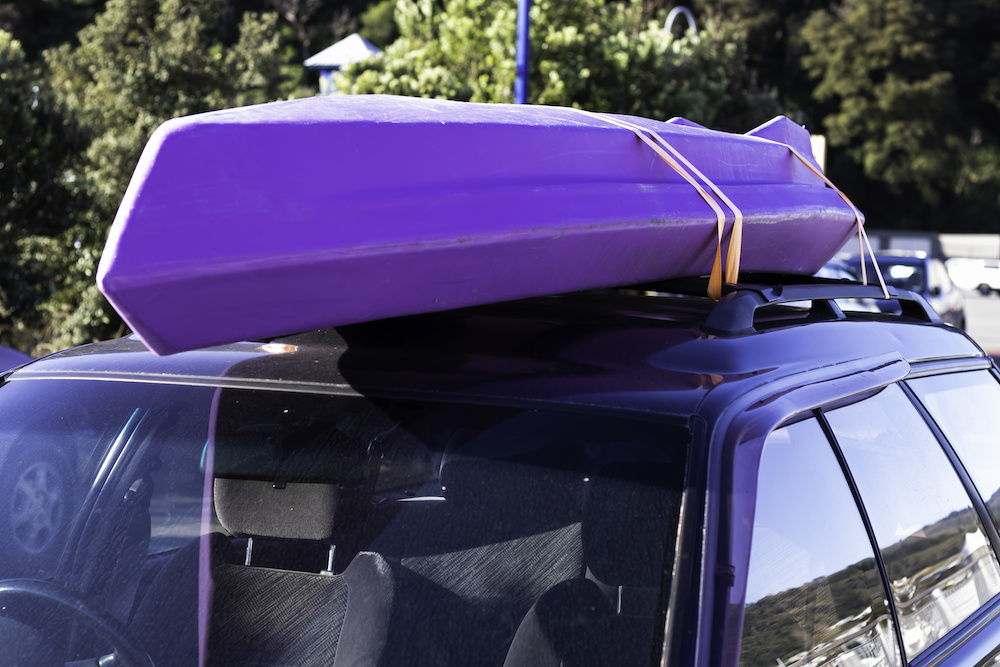How to Transport a Kayak in 3 Ways
We may earn a commission for purchases using our links. As an Amazon Associate, we earn from qualifying purchases.
Paddling along a picturesque river or a pristine lake in the summer has such an appeal that it pushes many to try kayaking.
The problem is that first-time paddlers have to face one crucial aspect that many others struggle with—how to transport a kayak.
You can’t just load it in your car and go; instead, you’ll have to really think about whether or not you have the means to take it to a nearby body of water.
To help you figure that out, let’s talk about how that’s done.
Preparing Your Kayak for Transport
Before deciding which kayak you’ll buy, you need to plan how you’re going to load it in your vehicle.
Generally, you should be aware of your kayak’s qualities, such as:
- Measurements (length and weight)
- Construction (vinyl, hard-shell, hybrid)
Knowing its specs and materials should go a long way in maximizing the transport options of your kayak.
Regardless of which transport method you prefer, make it a practice to follow the tips listed below.
1. Routine Strap Check
For kayaks and most cargo transport, checking all straps and lines before leaving is an unskippable step.
Many paddlers have the habit of pulling over regularly to double-check if all of the straps are fastened securely.
Not only the connection but the straps themselves must always be in their best condition.
Stopping multiple times during the trip may seem inconvenient, but the circumstances where the kayak falls off during transit are far more cumbersome.
As such, always consider checking the lines from time to time to confirm if they are still tight.
Rough roads could also affect the connections, so you might have to be extra vigilant if your route has plenty of those.
2. Use a Warning Flag
When a kayak is loaded, most average-sized private vehicles will have it a bit hanging from the vehicle’s rear.
This overhanging poses a safety risk to both you and the vehicles around you.
Attaching warning flags on the rear of the kayak should give it more visibility to the drivers around you.
While this is just a suggestion, some states mandate warning flags for those who transport kayaks.
Hence, we recommend that you check state road laws to avoid penalties.
3. Consider a Kayak Cockpit Cover
The primary purpose of a cockpit cover is to keep debris and clutter out of the kayak when in storage or is being transported.
If there’s no cover, the wind will cause an accumulation of debris and clutter to the inside of the kayak.
As a result, your anticipation of enjoying the water could quickly change to annoyance when you find that the kayak is full of dirt and is unusable until cleaned.
How to Transport a Kayak
Transporting a poorly fastened kayak can result in significant damage to your car and your kayak or endanger other motorists.
As such, you must consider which approach is ideal for you ahead of time.
Fortunately, there are options available for securing the kayak onto your vehicle.
Once you’ve figured that out, here are the three most common methods of transporting a kayak:
1. Roof Rack
When figuring out how to transport kayaks, you’ll find that the most common and economical solution is using a roof rack.
These transport accessories come in various designs, each tailored to the specifics of your vehicle.
Below are some of the most frequent kayak roof rack designs you’ll come across:
Crossbars
Crossbars are the base components for any kayak holding device you’ll place on the top of your automobile.
Typically, two crossbars run over the roof of your car.
They are mostly made of rubber and metal to protect your vehicle’s roof or your kayak from dents and other damages.
J-Style
J-style racks are slanted at around 45 degrees, as the name suggests.
You can load the kayak from the side of your vehicle when you opt for this type of transport accessory.
To secure everything, straps are then placed around the kayak after it is mounted.
Stacker
If you have a few paddlers in your family, a stacker roof rack is ideal because it can hold multiple kayaks at once.
Its design consists of vertical poles that attach to your crossbars.
The stacker is one of the least expensive ways to transport multiple kayaks, and it usually includes cam straps and other essential mounting hardware.
Roller
This type of kayak roof rack is installed on the crossbar and has rollers on the upper side.
With the help of the rollers, loading kayaks from either side is possible.
Saddle
Saddle racks have two grips that hook to your crossbars and secures your kayak underneath.

2. Kayak Trailer
If you have the budget, using a kayak trailer is arguably the best method of transporting kayaks, especially for bigger models.
After all, heavy fishing and touring kayaks might be challenging to hoist onto a roof rack by yourself or even with a partner.
What’s more, shorter paddlers may find it difficult to load their kayak onto a large vehicle.
Fortunately, using a kayak trailer will negate most of the inconveniences.
There are available trailer designs and variations to choose from, from do-it-yourself models to commercial lightweight folding trailers.
Before you opt for a kayak trailer, you should consider your kayak model’s qualities and how you use it.
Some trailers are constructed of abrasion-resistant materials but have a wiry design.
In contrast, others offer a large capacity ideal for family outings but are prone to the elements.
As such, you should think about the material of your kayak, the capacity of the trailer, and your budget limitations.
High-quality kayak trailers are often made of solid metal steel that combines a lighter weight with good corrosion resistance.
It would help to consider the tires, as they could make all the difference in transporting your kayak.
Smaller trailer tires are ideal for carrying lightweight kayaks, while larger trailer tires can handle heavier kayaks.
3. Use Large Vehicles
If the first two methods seem to be a bit too difficult for your taste because of the tools required or the needed preparations, maybe this option is for you.
You can always use a vehicle large enough to carry the kayak that requires less setup.
Here are vehicles you can use in transporting your favorite watercraft:
Pick-up Truck
Putting the kayak in the rear of a pick-up truck and fastening it with a handful of tie-downs is probably the easiest method.
You can do this by simply leaving the tailgate down and placing the kayak on the rear.
In most cases, you’d be able to hook the kayak into the bed of most vehicles.
Still, it would be best to do this as carefully as possible to avoid scratches, dents, and impact damage.
While it is relatively a straightforward procedure, failure to tie your kayaks properly might endanger other drivers or irreversibly damage the kayak itself.
If you have a long kayak, such as a tandem-type that extends out of your truck bed, it may not feel completely safe.
Even after you’ve tied it down with multiple straps, balance and support are still highly questionable.
To address this issue, consider a hitch-mounted truck bed extension, which adds length to the back of your pick-up truck.
It is the optimal solution if a significant part of your kayak is still hanging out the rear of your tailgate.
The extension provides additional support and also lessens the effort needed to load and unload the kayak.
SUV
While SUVs may not be as convenient as using a pick-up truck for transporting kayaks, they still have qualities that make them practical kayak carriers.
One of the primary reasons SUVs are ideal for carrying kayaks is that many models have built-in roof rails.
For this reason, you’d be able to install additional components almost effortlessly.
Large SUVs often have long roofs, too, which is beneficial for maintaining balance and support to the kayak while on transit.
Furthermore, they are excellent off-road vehicles.
More often than not, you will find yourself traveling off-road while attempting to reach the finest kayaking locations.
RV
Kayaks are an excellent way to make your camping trip more interesting and memorable.
It would be pretty hard to argue that there’s something better than having an RV and a kayak at the same time.
In fact, you may not even need racks if you attach the kayak vertically to the RV’s ladder on the backside.
An RV trailer is generally taller than the roof of most private cars, so securing a kayak in a vertical position is feasible.
Even so, racks are the best method to transport your kayak on your camper or RV because they are simple to install and remove.
An Inflatable Kayak Might Be More Practical
With a multitude of ways on how to transport a kayak, finding which one fits your preferences should be easy.
However, if you feel these options are not for you, opting for an inflatable kayak is your final resort.
They don’t typically require racks and straps, which will save you a bit of effort and time.
There’s also no danger associated with transporting inflatables.
Just remember that compared to hard-shell kayaks, they tend to be less durable.









